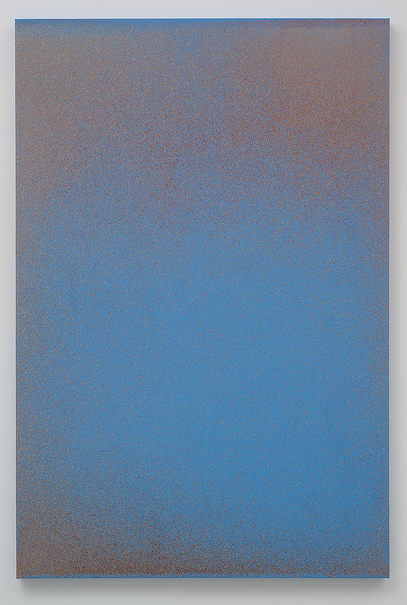A flyspeck is a tiny surface stain made when a housefly excretes its food. It’s barely noticeable until you take 60,000 flies, feed them watercolor paint, and restrict their movement to a canvas. That is what Los Angeles-based artist John Knuth started doing about eight years ago. The abstract paintings, made by the flies, sell for between $4,500 and $8,000. Seven new fly paintings are on view in Chicago at Andrew Rafacz Gallery, through May 10.
Knuth’s flies arrive in the mail to him as maggots. He raises them and feeds them a sugar water solution tempered with watercolor and gouache paints. The flies, tens of thousands of them, are constrained to an area surrounding the canvas. “When flies eat they digest externally. They’re in a constant state of regurgitation,” explains Knuth. “When they land on the surface they regurgitate a flyspeck.” With a 2–3 week lifespan, the flies help Knuth create just a single painting. “I work them to death,” says Knuth.
“The idea is kind of nasty,” says Knuth. “There’s nothing worse than a fly. But people are always surprised at how beautiful and delicate the paintings are.” Some canvases are as large as six feet tall. Knuth estimates he has made 30 such paintings using the flyspeck method.
Knuth likes the push and pull between the grotesque and the beautiful. He says the paintings are about transformation, and even calls them “elegant.” He’s right; without knowing how they were made, Knuth’s canvases pass as colorful, atmospheric abstractions.
Is it insect abuse? “I’ve been waiting for PETA to find me,” jokes Knuth, but he was concerned. He asked an entomologist to be sure. “The flies are living normal lifespans, they’re active and sexually active,” says Knuth. “If you’re having sex and living a normal lifespan, that’s pretty good.” Even better, perhaps, if your whole existence is dedicated to making art.
John Knuth shows at Andrew Rafacz Gallery, 835 W Washington, April 5–May 10.



